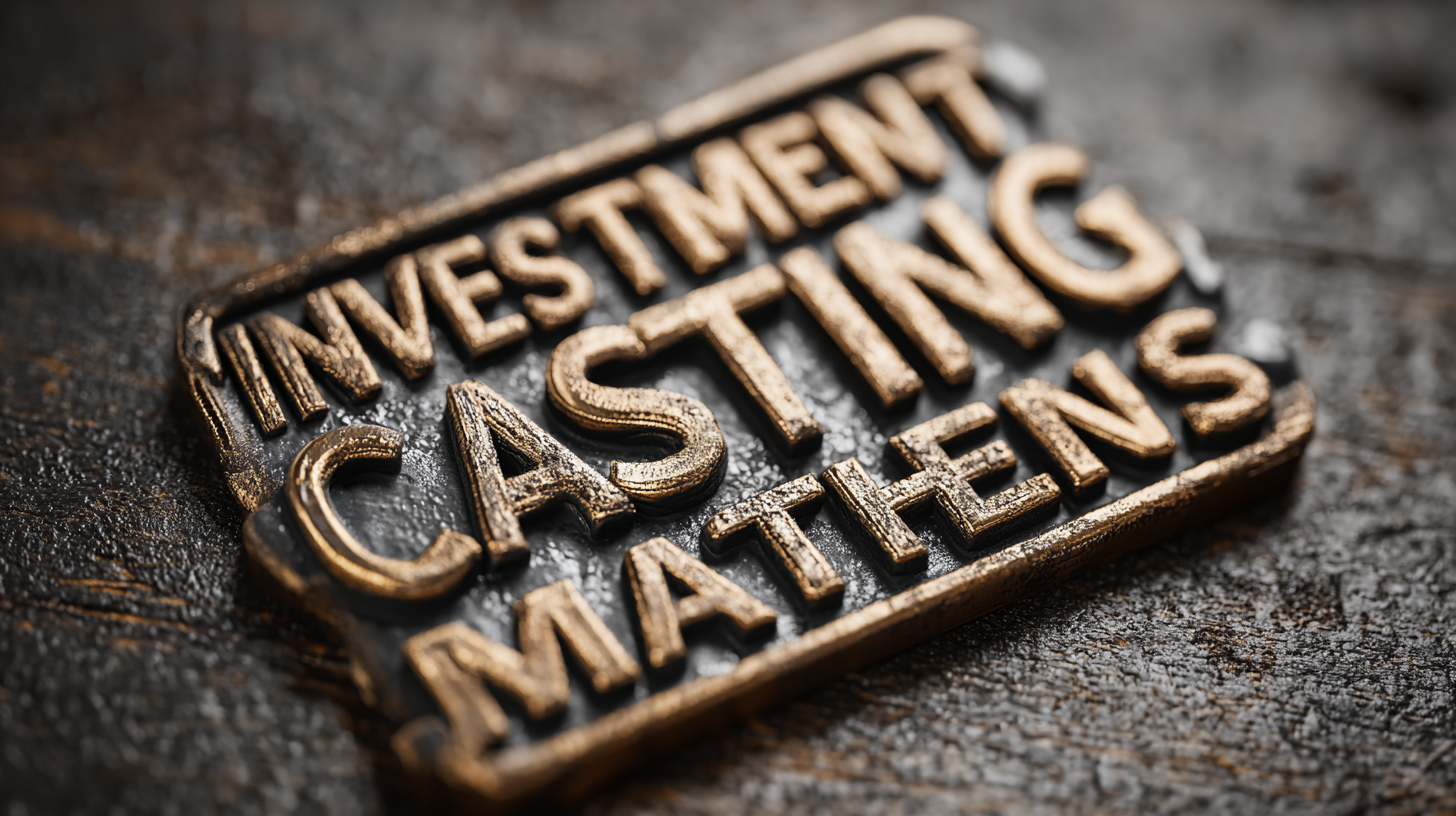 +86 180 0293 5268
+86 180 0293 5268






The Investment Casting Metals market is poised for significant evolution by 2025, driven by advancements in technology and increasing demand across various industries. According to a recent report by Market Research Future, the global investment casting market is projected to reach approximately $17.3 billion by 2025, growing at a CAGR of 5.2% from 2019 to 2025. This growth is attributed to the rising demand for precision components in sectors such as aerospace, automotive, and healthcare. As manufacturers seek to optimize production processes and enhance material performance, the selection of investment casting metals will become increasingly crucial. With a focus on lightweight and high-strength materials, the market will likely witness a shift towards innovative alloys and composites, providing a deeper understanding of the underlying trends and opportunities that will shape the landscape of investment casting for years to come.

Emerging alloys are set to redefine the landscape of the investment casting metals market by 2025, bringing forth innovations that cater to enhanced performance and efficiency. As industries increasingly focus on lightweight yet strong materials, these advanced alloys are being developed to meet the rigorous demands of sectors such as aerospace, automotive, and energy. The interplay of material science and engineering is leading to the formulation of high-temperature alloys and other specialized materials, which can withstand extreme conditions without compromising structural integrity.

The investment casting market is poised for significant growth, with projections indicating a size of USD 27.22 billion by 2032, fueled by a robust CAGR of 5.1% from 2023. This growth can be attributed to the rising adoption of investment casting techniques due to their ability to produce intricate shapes and superior surface finishes. Furthermore, as more manufacturers seek to optimize production processes and reduce waste, the shift towards emerging alloys represents a pivotal change in casting practices, shaping the future of metal manufacturing by 2025 and beyond.
The investment casting metals industry is poised for notable growth as we move towards 2025. Projections indicate that the global market will continue to evolve with increasing demand driven by advancements in technology and heightened applications across various sectors, particularly in automotive and aerospace. The investment casting process, known for its precision and ability to create complex geometries, will see innovations that enhance efficiency and production capabilities.
Moreover, market analysis suggests that specific metals, including aluminum and titanium, will dominate the investment casting landscape due to their favorable properties and lightweight nature. The overall investment casting market is expected to reflect a healthy compound annual growth rate (CAGR), attracting both established players and new entrants eager to capitalize on future opportunities. As sustainability trends gain momentum, the recycling of metals will also play a critical role in shaping the industry's dynamics, further driving the integration of eco-friendly practices within the investment casting framework.
The advancements in casting techniques are poised to significantly influence the
investment casting metals market by 2025.
One noteworthy trend is the integration of additive manufacturing (AM)
into traditional casting processes. AM offers innovative and cost-effective solutions that can
enhance design flexibility, reduce waste, and facilitate the production of
complex geometries that were previously unattainable with conventional methods. As industries such as
aerospace and automotive
increasingly adopt these technologies, we can expect a shift towards more sustainable practices,
aligning with global development goals.
Moreover, the emergence of advanced materials in investment casting
is set to redefine manufacturing standards. Recent studies on 3D printing materials
indicate a growing interest in composites and alloys that improve performance characteristics. These innovations
not only address the limitations of existing casting metals but also expand their applications across various sectors.
In essence, as technological advancements continue to reshape the landscape, the investment casting metals market
will likely experience a transformation driven by both the incorporation of cutting-edge techniques and the development
of specialized materials, fostering a more efficient and environmentally responsible manufacturing future.

Sustainability has become a pressing concern across various manufacturing sectors, and the investment casting metals market is no exception. According to a report by Grand View Research, the global investment casting market is expected to reach USD 22.54 billion by 2025, growing at a CAGR of 5.5%. As demand increases, the focus on eco-friendly practices in the production of investment casting metals has intensified. Companies are now prioritizing the use of recycled materials and eco-efficient processes to minimize waste and energy consumption during casting operations.
An essential metric in this sustainability shift is the carbon footprint associated with the metal production process. For instance, research indicates that using recycled metals can reduce greenhouse gas emissions by up to 60% compared to virgin materials. Additionally, the integration of renewable energy sources in foundries is proving to be a viable solution for lowering emission levels. Industry leaders are not only adopting cleaner technologies but are also increasingly transparent about their sustainability metrics, which fosters trust and accountability in their operations.
As the investment casting sector embraces these eco-friendly practices, the landscape of manufacturing is set for a substantial transformation, aligning economic growth with environmental stewardship.
The investment casting metals market is poised for significant growth as we approach 2025, driven by increasing industrial applications and technological advancements. Key players in this market are focusing on innovation and strategic partnerships to enhance their competitive edge. For instance, the global steel casting market is projected to expand by USD 7.23 billion from 2025 to 2029, mainly fueled by the burgeoning construction sector. This trend highlights how important it is for companies to adopt cutting-edge manufacturing processes like investment casting to meet the rising demand for high-quality steel products.
In the Asia-Pacific region, the metal casting market is expected to witness a CAGR of 4.111%, reaching a value of USD 105 billion by 2035. As markets like India are set to grow from USD 13.48 billion in 2024 to USD 25.48 billion by 2035, local players are increasingly investing in advanced casting technologies that facilitate better precision and efficiency. This competitive landscape underscores the necessity for market leaders to adapt their strategies according to regional growth patterns and consumer demands, ensuring they capture a larger market share in the evolving investment casting sector.
| Metal Type | Market Share (%) | Growth Rate (%) | Key Applications | Strategic Focus |
|---|---|---|---|---|
| Stainless Steel | 30 | 5 | Aerospace, Automotive | Innovation in Alloys |
| Aluminum | 25 | 7 | Consumer Goods, Electronics | Cost Reduction |
| Iron | 20 | 3 | Construction, Heavy Machinery | Sustainability Initiatives |
| Nickel Alloys | 15 | 6 | Petrochemical, Marine | Market Expansion |
| Cobalt Alloys | 10 | 4 | Medical, Aerospace | Innovation and R&D |
